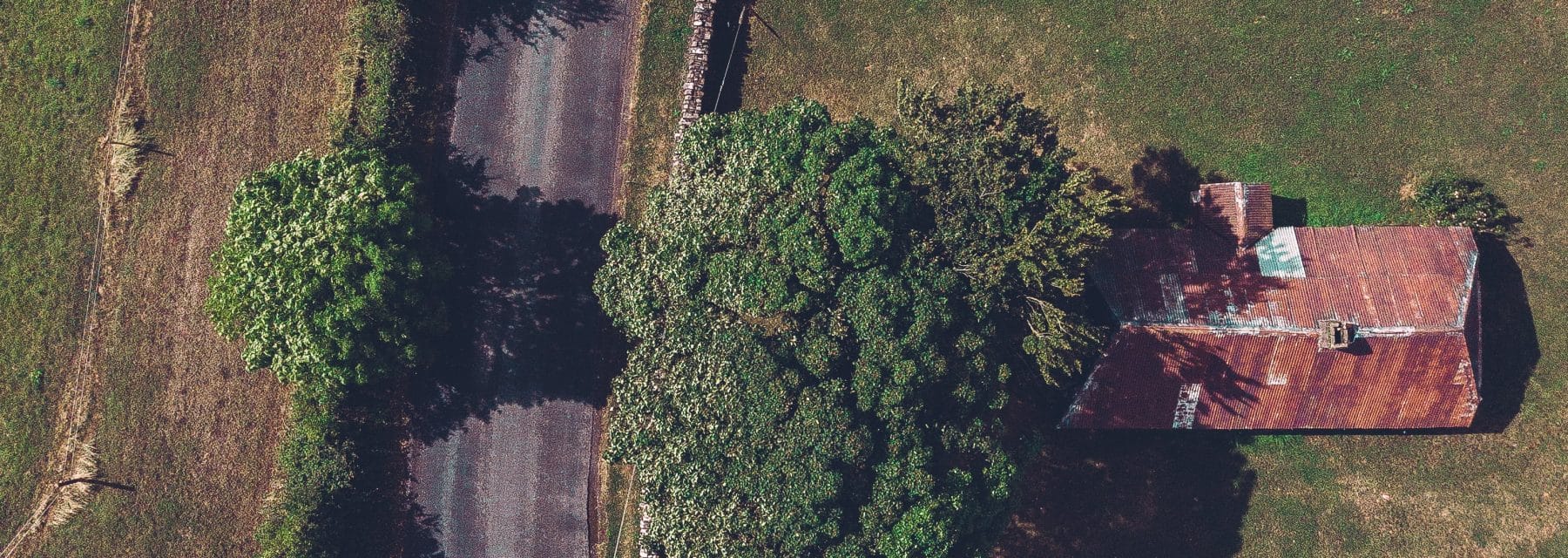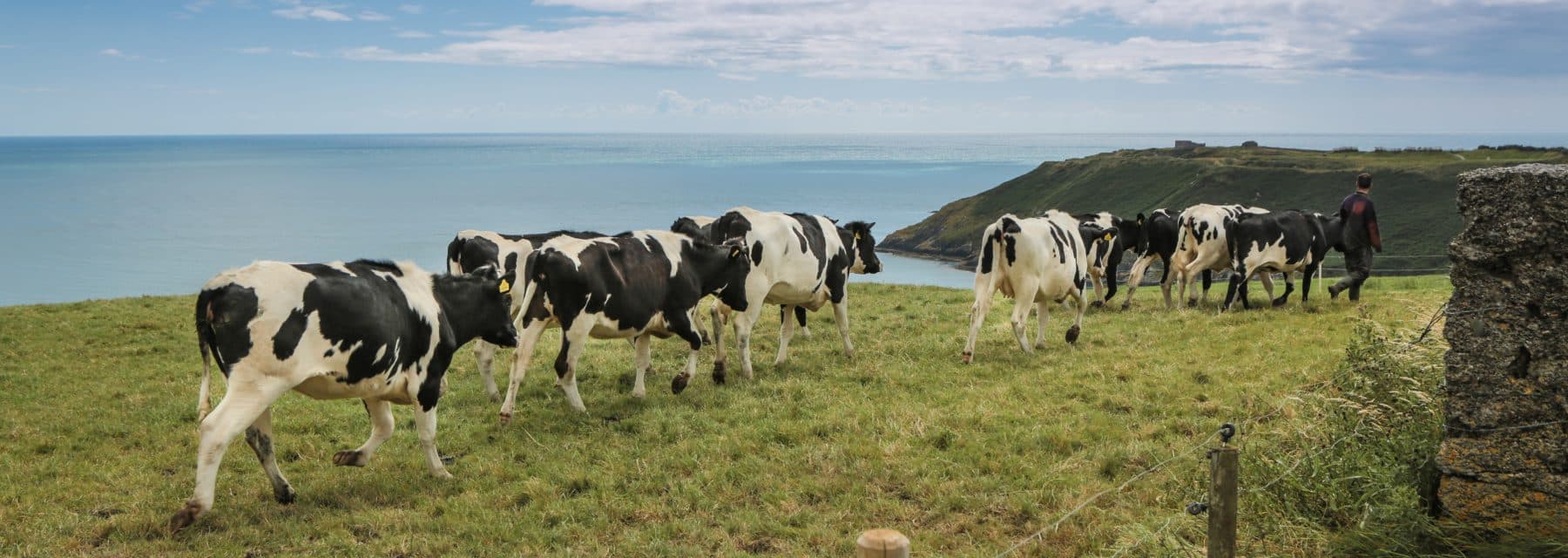
Transforming Ireland’s land and agri-food system
Our approach
Collaborate
Demonstrate
Learn
Change


 Initiated by the EIT
Initiated by the EIT

To successfully transform a system, we need to develop a deep understanding of the dynamics at play. If not, we risk instability and unforeseen effects, as multiple yet interconnected factors pull in different directions.
Climate KIC’s Deep Demonstration methodology is a collaborative process aiming at transforming whole places, in cities, regions and industries. By working together with all those involved – farming communities, citizens, policymakers, businesses, researchers – we go through a continuous loop of experimenting, testing and learning to find what really works (and what doesn’t) and accelerate the innovation cycle.
We have gathered a deep understanding of the unique context of the Irish agri-food sector.
Agriculture is not only Ireland’s largest domestic sector, but it has profound ties to the country’s social and cultural fabric. There are approximately 137,000 farms scattered across the country, with an average size of 32 hectares, often going back many generations.
Many initiatives to make food healthier and more sustainable are flourishing: we have been building key relationships with those and are helping shape a common vision and commitment to change.
Once we demonstrate what a sustainable food system may look like, action follows suit. Building on our comprehensive mapping of the system and on the input of more than 500 key on-the-ground actors, we have identified a portfolio of over 280 mutually-reinforcing innovative solutions, grouped under 7 high-potential areas.
Now, we are implementing 4 of these frameworks, with the help of local and international partners, from reducing dairy emissions in farms and creating a national carbon farming scheme to fostering circular bioeconomy in regions and shaping a new vision for farming.
By experimenting together in a de-risked environment, we can uncover deep insights to verify what works, rapidly and at scale. Those lessons are gathered and shared widely to keep testing, learning, and adjusting together.
The solid framework and innovation cycle we have established allows all our partners to embed systems thinking in their work, creating a ripple effect that amplifies impact and accelerates transformation.


After mapping the Irish land and agri-food system to identify key actors, issues, initiatives and opportunities, we have identified seven high-potential innovation areas underpinned by 280 on-the-ground projects. We will be implementing four of these seven frameworks between 2024 and 2025.
Click on each flagship to learn about our workplan and how you can get involved:
The objective of this flagship is to create a long-term, ambitious vision for Ireland’s land and agri-food system, to guide the existing strategy in the right direction, to increase stability of and trust in policy processes, and to attract investment.
We aim to include a broad range of communities and experts (younger generations, citizens and consumers, creative industries and other sectors) to ensure all perspectives and imaginations are captured – because the future of Irish food systems is everyone’s business.
Ireland is at a crossroads: it has the potential to become a model for other countries on how to thrive and create value for the entire agri-food system, while safeguarding its natural assets for future generations.
We need to establish this vision and roadmap now, to set the right direction and to provide continuity and long-term certainty to all those who will be the agents of this transition.
We will achieve this by democratically convening everyone – not only agri-food stakeholders, but also universities, consumers, citizen assemblies and creative sectors across the regions – to chart an inclusive and participatory vision of what the Irish food system will look like in 2050: healthier, resilient, sustainable, and nature-based.
Objectives
Where’s the innovation?
We will involve a broad range of voices from the Irish society (including farmers, industry, researchers, citizens, young people, creatives) to define and create a future common vision of what a sustainable land and agri-food system will look like in 2050
Timeline and key activities
Partners
The objective of this flagship is to identify new, strategic areas for the land and agri-food sector to grow, in line with the 2050 vision of a climate neutral and resilient system. The innovative value chains identified will position Ireland as a forward-thinking country with a fertile environment for new businesses, attracting foreign investment.
Diversifying the land and agri-food system will increase resilience to supply chain shocks and climate risks. This will help the sector grow and create new jobs and skills, by integrating innovative value chains and products while building on Ireland’s existing natural assets and capabilities.
Any new value chain must from its inception be designed to be climate neutral and provide additional value to existing sub-sectors, to ensure they’re not competing, but rather reaping the benefits of emerging trends and technologies currently not applied.
To ensure this, each of the sub-sectors identified will be in line with the 2050 vision formulated in Flagship 1. We will closely work with the finance, policy and education sector to develop detailed market analyses and recommendations for new policies and skills.
Objectives
Where’s the innovation?
We will identify new, strategic sub-sectors to grow and diversify the land and agri-food system, to ensure Ireland stays at the forefront of emerging trends and technologies and creates fertile ground for new, well-paying jobs, skills and economic opportunities.
Timeline and key activities
Partner
This flagship seeks to promote circular bioeconomy solutions that are holistic and integrated by design, while putting rural and coastal communities, regions and cities at the heart of this transition. Underpinning this work is widespread engagement with local groups to raise awareness and pride in regional excellence and create solutions that work for all.
Regions will be encouraged to review their operating models, energy networks, waste streams and food production to identify opportunities to shift from linear to more circular approaches. This could be linked to side streams and waste streams from primary producers and processors, as well as food waste from consumers and food service operators.
Projects under this flagship will also support and incentivise collaboration across value chains to identify industrial symbiosis opportunities and high-potential activities such as biomass production on land or in water. It will also promote specific expertise and infrastructure based on ‘smart specialisation’, or the unique opportunities for development and growth that each region has, in line with the 2050 vision.
Objectives
Where’s the innovation?
We will help develop regional innovation strategies for circular bioeconomy that valorise the unique resources and growth opportunities of each region, while identifying common barriers to implementation and promote cross-regional collaboration to replicate and scale concrete solutions.
Timeline and activities
Partners

This flagship focuses on the transition to a more equitable system where farmers are rewarded for their activities that help sequester carbon, enhance soil, water and air quality, and overall increase biodiversity. Core to this is the development of a national carbon farming and nature credits framework that drives adoption of sustainable farm practices, at scale.
The classic definition of carbon farming involves agricultural and land management practices designed to sequester carbon dioxide from the atmosphere and improve soil health, such as agroforestry, cover cropping, and rotational grazing.
What our partnership will develop in Ireland is much more comprehensive and will include carbon removals (through trees, hedgerows, soil etc.), emission reductions across a range of sources (from soils to fertilisers, slurry and manure, enteric fermentation, fossil fuel use, etc.), and biodiversity and water quality indicators.
There are currently many organisations working on different pieces of the puzzle. This flagship will pull these strands together, amplifying these existing initiatives and addressing gaps, to develop Ireland’s first national carbon farming framework.
The framework, set out as a key enabling element in Ireland’s Climate Action Plan 2024, will cover objectives and principles, governance as well as monitoring, reporting and verification mechanisms, financing pathways, and capability building.
Once the national framework has been approved, a large-scale implementation phase will be launched to test it and improve it. This phase will prove the concept for potential investors and will provide an opportunity to iron out any issues before going to scale.
Overall, the flagship activities will integrate learning approaches; will amplify local, national and international knowledge and initiatives; and will attract alternative funding sources to pay for these ecosystem services.
Objectives
Where’s the innovation?
We will help develop Ireland’s first-ever national carbon farming framework, and attract new investment to diversify value and income streams based on ecosystem services in addition to production. We will do so by pulling together ongoing efforts and schemes on carbon sequestration and farm biodiversity practices, to provide a baseline for monitoring and payments.
Timeline and activities
Partners
This flagship aims at defining what a sustainable beef enterprise is, across social, environmental and economic indicators, with the goal of developing an evidence-based, certified model for climate-neutral beef production.
Cattle farming is the dominant agricultural system in Ireland, but it faces low profitability compared to other farming methods. Unlike dairy farming, beef production in Ireland is less intensive and generates lower overall emissions. While there’s a belief that a significant number of beef farms could achieve carbon neutrality with a few measures, solid evidence supporting this is currently lacking.
This flagship will build on existing research to understand the sustainability baseline of beef systems, with the goal of evaluating the potential for increased economic returns through the production (and eventual certification) of carbon-neutral beef.
We will test various options available through Teagasc’s Signpost Farm’s Programme as well as the Sustainable Beef and Lamb Assurance Schemes and emerging sustainability price incentive schemes in the meat sector. The flagship will also explore the possibility of farmers being rewarded for providing ecosystem services, with consideration given to market prices, in alignment with Flagship 4.
By collaborating with industry partners to develop a certified climate-neutral beef production system, we aim to gather insights that will shed light on the future of Irish beef, helping farmers and processors envision a sustainable and economically viable path forward.
Objectives
Where’s the innovation?
By building strong collaborations within the beef value chain and amplifying existing sustainability initiatives, we will develop a shared definition for climate-neutral beef production, adaptable to different types of producers. In addition, we will identify the value of a potential market premium for climate-neutral beef.
Timeline and activities
Partner
This flagship aims at facilitating the transition towards a more sustainable dairy industry, adapting to a ‘new normal’. It will do so by co-developing a model for sustainable dairy production in Ireland and testing the different combinations of policy, technology and value chain implications, by implementing it on the ground with dairy farmers.
Although dairy accounts for less than 18% of farms, it contributed approximately 43% of agriculture’s total emissions in 2019, and in 2022 accounted for 59% of aggregate farm incomes. There is currently no agreement on what ‘sustainable dairy production’ actually means, and what the future implications of this might be for the dairy sector as a whole.
The Sustainable Dairy Assurance Scheme already incorporates proven on-farm sustainability measures to reduce emissions. This flagship will build on this and other existing work to develop and test evidence-based emission reduction solutions at large scale. Around 200 dairy farms will be directly involved in concrete activities.
The outcomes will inform national and EU policy, and potentially contribute to more realistic models in the 2027 update of the Common Agricultural Policy.
The flagship also plans to understand and address the barriers to adoption of existing sustainability measures on farms and gain further support among farmers and processors.
Objectives
Where’s the innovation?
We will help define and agree on a model for sustainable dairy production and test these conditions on different farm typologies. This will allow the Irish dairy sector to better understand the long-term implications and overcome barriers to implementation.
Timeline and activities
Partners
This flagship aims at expanding the tillage sector to take advantage of its low emissions, relative profitability, and potential for increasing the agri-food system’s diversification and resilience. It will build collaborations within the sector and with other industries to address low investment, increase trust, and identify opportunities for new, high-value crops and products.
The tillage sector has the lowest emission contribution in the land and agri-food sector, and it has the potential to reduce this even further by adopting diverse crops and farm management practices. At the same time, it is the second most profitable sector after dairy production.
In addition, there is a need to substitute import of products with a relatively high carbon footprint and increase resilience in supply chains by expanding crop cultivation in Ireland. There is also huge potential for the tillage sector to support the expansion of Ireland’s bioeconomy by growing and processing non-traditional crops, including as a measure to reduce emissions from farmed peatlands.
The sector has a target to increase the area under tillage to 400,000 hectares by 2030. This will require collaboration both within the sector and across other sectors to develop circular farming models and to make land available for expansion. This flagship will build on the work of the Food Vision Tillage Group, who will produce their final report in 2024.
Objectives
Where’s the innovation?
We will expand a high-potential yet traditionally undervalued sector through innovative and regenerative farming practices, stronger value chain collaborations, and new opportunities for high-value, low-emission crops and products.
Timeline and activities
Partner


According to the Irish Environmental Protection Agency, agriculture currently contributes 38% of the total greenhouse gases emitted in Ireland. This is almost three times the average in Europe and indicates the significance of agriculture in the Irish economy. Greenhouse gas emissions on Irish farms come primarily from:
The latest estimates show that total emissions in the agriculture sector have increased by 15% from 1990 to 2021, mainly driven by a 17.7% increase in methane emissions from enteric fermentation and a 29.6% increase in emissions from manure management.
Agriculture is Ireland’s oldest and largest domestic sector, undergoing a 50% increase in size in the last 10 years, with food exports at a record €15.4 billion in 2021.
In 2021, the agri-food sector in Ireland:

As part of the Deep Demonstration process, we ran several workshops with stakeholders to gather these deep insights, such as:
The power imbalance and resulting lack of trust across some value chains has come out strongly as a key area to be addressed. The role of policy to potentially drive innovation, as opposed to the perception of being a barrier or lacking in agility to respond to needs in a timely way, also emerged strongly.
Farmers’ perception is that ‘they are unduly picked on’. Business models that reward farmers for environmental services and changes in land use are needed, while balancing and recognising their strong cultural ties to the land and livestock. These are not incompatible goals, and engagement with farmers in developing solutions is critical to foster a shared sense of ownership and commitment.
The team behind the Ireland Deep Demonstration identified the needs, assets, resources and competences, as well as external conditions, required to achieve the vision of a sustainable food system by 2030. This mapping returned a 360-degree picture:

• Saskia Visser, Programme lead • Stewart Gee, Carbon Farming, Dairy, Beef & Tillage lead • Denyse Julien, Future Vision, New Value Chains & Circular Bioeconomy lead